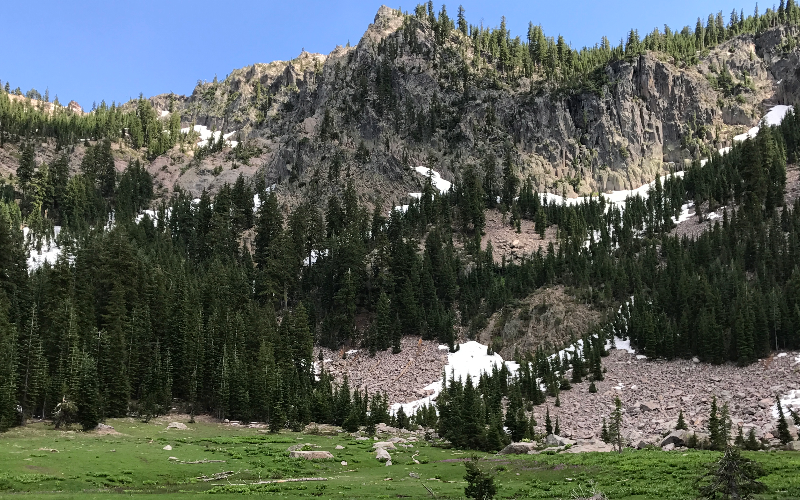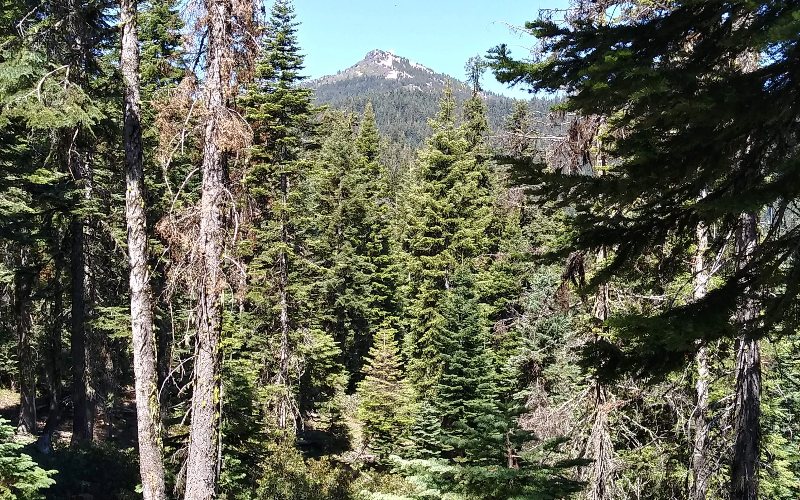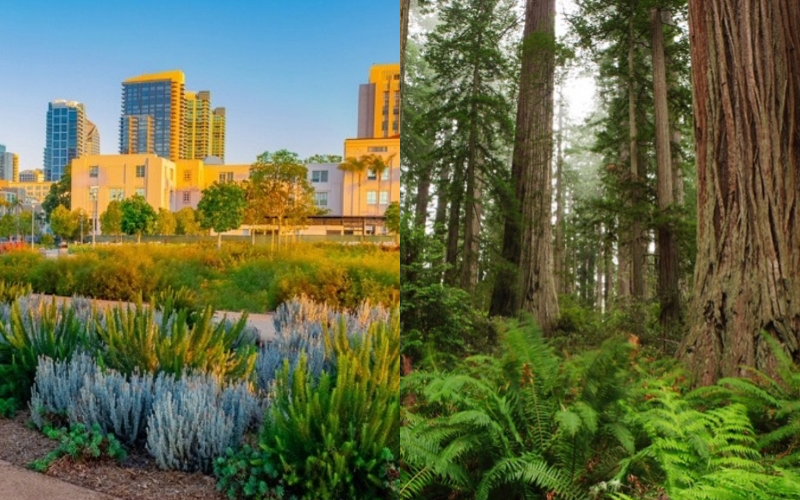FOREST FLASH
November 2023
In Pacific Forest Trust’s e-newsletter, Forest Flash, we send you the most recent PFT news and updates on forests, clean water, climate, and wildlife. Subscribe here.

Thanks to a generous grant made by California’s Wildlife Conservation Board, PFT is one step closer to conserving the Shasta Timberlands Working Forest! Once completed, with a close anticipated by the end of December, this project will be a triumph for landscape-scale conservation. Nestled in the lush, forested ridges along Mount Shasta’s northeastern slopes, this 7,500-acre conservation effort will achieve numerous objectives, including advancing California’s ambitious “30×30” goals, which seek to protect 30% of the state by 2030 in order to protect the state’s amazing biological heritage.
The decision to safeguard this ecological treasure through a Working Forest Conservation Easement is a rare opportunity for strategic integration of public and private working lands in order to provide connected and conserved habitat for hundreds of species. The forest itself has a stunning array of habitats, supporting over 250 species alone, and in addition it provides a pivotal steppingstone building a resilient and well-managed landscape across ownerships so that wildlife can thrive in a changing climate. The Shasta Timberlands project connects across both the Shasta Trinity and Klamath National Forests, as well as the Hart’s Butte Creek Ranch conserved by PFT in 2015, thus forming a crucial network for benefitting hundreds of species of animals, fish and plants.
We are grateful that our partners, landowner TC&I Shasta, LLC, and its forest manager Campbell Global, LLC, share in our vision for promoting climate resiliency alongside sustainable forest economies as key goals of this project. To achieve the former, future management of this property will focus on restoring the older, more natural forest with a diverse and healthy mix of native trees: Shasta red fir, white fir, and ponderosa pine, among others that underpin this forest type and its natural resilience. This focus on management for natural forest function will also help reduce the risk of the large and catastrophic wildfires.
So, here’s to colossal progress for landscape linkage in an essential area! We could not be prouder of conserving this property to help cap off our 30th year—a testament, in many ways, to our enduring commitment to nurturing the vitality of this extraordinary forest ecosystem.

 In a significant stride toward broadening the scope of our environmental stewardship in southern Oregon, we are delighted to announce the latest addition to our team, Emily Bowes, who will be taking on the role of Stewardship and Outreach Associate for the Mt. Ashland Demonstration Forest.
In a significant stride toward broadening the scope of our environmental stewardship in southern Oregon, we are delighted to announce the latest addition to our team, Emily Bowes, who will be taking on the role of Stewardship and Outreach Associate for the Mt. Ashland Demonstration Forest.
Emily, who hails from the region and comes to us with a decade of experience in natural-resource work, has a demonstrated commitment to participating in broad-scale conservation initiatives, as well as environmental education and community engagement opportunities. Her professional journey underscores a clear dedication to the conservation of this essential area, making her an excellent person to leverage and share what we learn from managing the Mt. Ashland Demonstration Forest. “This role,” says Emily, “allows me to support PFT’s mission of sustaining private forests for all their public benefits…. I look forward to making a meaningful impact and contributing to the conservation of well-managed, fire-adapted forests.”
The Demonstration Forest, which is situated on Mt. Ashland’s north side, consists of 1,130 acres of conifer forests, replete with wet meadows and streams. This property embodies the region’s hallmark biodiversity with a stunning variety of wildlife and plants. The Forest is also a key part to the protected corridor we have been building along the Siskiyou Crest from the Cascade Siskiyou National Monument to the Rogue Siskiyou National Forest. With Emily’s help, we look forward to sharing our learning, insights and experiences in the Demonstration Forest with landowners, students, community members, and other stakeholders.
We are immensely grateful to the M.J. Murdock Charitable Trust for enabling us to establish this position!
Please consider a donation to the Pacific Forest Trust. Your help—in all capacities—makes our work possible. Thanks for supporting us as we support forests!

In November California’s AB1757 Expert Advisory Committee (EAC) on Natural and Working Lands (NWL), chaired by PFT’s President, Laurie Wayburn, delivered its report and recommendations for implementation targets and actions in the NWL sector. Citing that major gains towards the state’s climate goals can be made in this sector—250-400 million metric tons of carbon dioxide reductions in the next 5-10 years–this is a first-in-the-nation effort to harness the power of this sector/. The NWL sector is comprised of 7 land types: Forest, Agricultural, Desert, Developed, Grass, Shrub, and Wetlands. The EAC’s focus was both to enhance durable carbon sequestration and to promote adaptation and resilience within a changing climate. As such, achieving key “co-benefits” from the sector, from improved water security to reduced risk from natural disasters of fires and floods to improving conditions in frontline communities most impacted by climate change and saving irreplaceable biodiversity, amongst others, were also core to the recommendations.
While there are specific approaches to gaining both emissions reductions and promoting adaptation for each land type, there are several core recommendations that are universal across all sectors. A central cross-cutting recommendation is to accelerate and scale-up the restoration, conservation, and management for natural-systems functions across landscapes. Another is the integration of short-term actions of restoration with long-term conservation of the land base that provides us with these climate benefits, thus ensuring these gains endure.
Recognising the we are in the critical window of opportunity to reduce CO2 emissions—scientists warn that we have less than a decade to make substantial progress before irreversible changes are set in place-the EWAC focussed on actions that make a very material difference in the next 5-10 years. The gains from the NWL sector can be made with investments far lower than for other sectors and using proven, often market-based- approaches that work within our existing economies.
Given the scale of gains that can be made in the short term, which exceed those from any other emissions sector, the EAC called for investments on par with those which are being made in the transportation and energy sectors. The Committee urged an investment of $10B over the next 5 years to achieve this goal.
Forests are the largest and most expandable land type of the NWL sector (already storing 85% of the state’s biological carbon, but currently holding less than half their natural potential) and the report lays out both practical and ambitious goals for forests. The EAC’s forest proposals are reinforced by a recent study published in Nature, subsequently covered by the New York Times, which identifies that restoring forests in their natural habitats could potentially capture an additional 226 gigatons of planet-warming carbon — equivalent to about a third of human-caused emissions since the Industrial Era began!
We are honored to be part of the EAC’s as the state’s chart’s a new course for California’s natural and working lands, and to help lay the groundwork for their transformation from sources of carbon and climate risk into indispensable players in the fight against climate change. These comprehensive recommendations offer a model and a path forward for the effective management of diverse landscapes nationwide. You may find the full report here.
ICYMI
In case you missed it (ICYMI), here are some other exciting things PFT has been involved in lately!
- In a recent Letter to the Editor for the New York Times, PFT President Laurie Wayburn re-ups the remarkable ability of older, more natural forests to capture extraordinary amounts of carbon, and highlights California’s pioneering efforts to harness the power of its natural and working lands.
- On the Camp Fire’s 5th anniversary, PFT’s VP of Policy & Incentives, Paul Mason, took to the pages of the Sacramento Bee to lay out means of preventing such catastrophic blazes in the future.
- Please join us for a Portland screening of Beyond the Trees, the award-winning documentary about PFT’s efforts on the van Eck forests in Oregon & California. We hope you’ll join us December 13th at 8pm! RSVP here.

